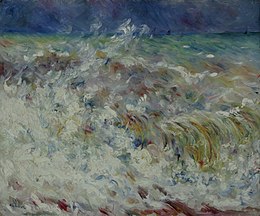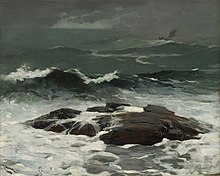
The North Sea lies between Great Britain, Denmark, Norway, Germany, the Netherlands, Belgium and France. An epeiric sea on the European continental shelf, it connects to the Atlantic Ocean through the English Channel in the south and the Norwegian Sea in the north. It is more than 970 kilometres (600 mi) long and 580 kilometres (360 mi) wide, covering 570,000 square kilometres (220,000 sq mi).

A wind farm or wind park, also called a wind power station or wind power plant, is a group of wind turbines in the same location used to produce electricity. Wind farms vary in size from a small number of turbines to several hundred wind turbines covering an extensive area. Wind farms can be either onshore or offshore.

Easington is a small village and civil parish in the East Riding of Yorkshire, England, in the area known as Holderness. A coastal settlement, it is situated between the Humber estuary and the North Sea at the south-eastern corner of the county, and at the end of the B1445 road from Patrington. The coastal town of Withernsea is approximately 6 miles (10 km) to the north-east.
Landscape assessment is a sub-category of environmental impact assessment (EIA) concerned with quality assessment of the landscape. Landscape quality is assessed either as part of a strategic planning process or in connection with a specific development which will affect the landscape. These methods are sub-divided into area-based assessments or proposal-driven assessments, respectively. The term 'landscape assessment' can be used to mean either visual assessment or character assessment. Since landscape assessments are intended to help with the conservation and enhancement of environmental goods, it is usually necessary to have a fully geographical landscape assessment as a stage in the process of EIA and landscape planning. During the initial phases of a project, such as site selection and design concept, the landscape architect begins to identify areas of opportunity or setbacks that may provide constraints. The architect prepares alternative options in order to compare their assessments and identifies the proposals which allow for the least adverse effects on the landscape or views. A landscape professional works with a design team to review potential effects as the team develops a sustainable proposal. Upon developing a design proposal, the landscape professional will identify and describe the landscape and visual effects that may occur and suggest mitigation measures to be taken in order to reduce negative effects and maximize benefits, if any.

Wind power in Germany is a growing industry. The installed capacity was 55.6 gigawatts (GW) at the end of 2017, with 5.2 GW from offshore installations. In 2020, 23.3% of the country's total electricity was generated through wind power, up from 6.2% in 2010 and 1.6% in 2000.

As of 2020, Estonia has a wind power installed capacity of about 320 MW. All operational wind farms in the country are on land. Offshore wind farms are planned on Lake Peipus and in the Baltic Sea near the island of Hiiumaa.

Wind power is the fastest-growing renewable energy technology in Scotland, with 11,482 megawatts (MW) of installed wind power capacity by Q1 2023. This included 9,316 MW from onshore wind in Scotland and 2,166 MW of offshore wind generators.

In 2021 France reached a total of 18,676 megawatts (MW) installed wind power capacity placing France at that time as the world's seventh largest wind power nation by installed capacity, behind the United Kingdom and Brazil and ahead of Canada and Italy. According to the IEA the yearly wind production was 20.2 TWh in 2015, representing almost 23% of the 88.4 TWh from renewable sources in France during that year. Wind provided 4.3% of the country's electricity demand in 2015.

The Burbo Bank Offshore Wind Farm is a 348 MW offshore wind farm located on the Burbo Flats in Liverpool Bay on the west coast of the UK in the Irish Sea. It consists of an original 90 MW wind farm commissioned in 2007 and a 258 MW extension completed in 2017.

The environmental impact of electricity generation from wind power is minor when compared to that of fossil fuel power. Wind turbines have some of the lowest global warming potential per unit of electricity generated: far less greenhouse gas is emitted than for the average unit of electricity, so wind power helps limit climate change. Wind power consumes no fuel, and emits no air pollution, unlike fossil fuel power sources. The energy consumed to manufacture and transport the materials used to build a wind power plant is equal to the new energy produced by the plant within a few months.

Offshore wind power or offshore wind energy is the generation of electricity through wind farms in bodies of water, usually at sea. There are higher wind speeds offshore than on land, so offshore farms generate more electricity per amount of capacity installed. Offshore wind farms are also less controversial than those on land, as they have less impact on people and the landscape.
Triton Knoll Wind Farm is an 857 MW round 2 offshore wind farm 33 kilometres (21 mi) off the coast of Lincolnshire, in the North Sea, England.

Humber Gateway Wind Farm is an offshore wind farm 8 kilometres (5 mi) east of Spurn Point off the coast of North East Lincolnshire, in the North Sea, England; the wind farm is located in water depths around 15 metres (49 ft) and covers an area of approximately 25 square kilometres (9.7 sq mi). The wind farm became operational in June 2015.
Navitus Bay Wind Park was a proposed 970 MW Round 3 offshore wind farm, to be situated off the English coast approximately 10 km south of Dorset and the Isle of Wight. The wind farm was refused planning permission in September 2015.
The Celtic Array was a proposed UK round 3 offshore wind farm in the Irish Sea south east of the Isle of Man.
First Flight wind farm was a late 2000s proposed offshore wind farm in the Irish Sea, southeast of the southern coast of County Down, Northern Ireland.

Wind power in Maryland, which has land-based and offshore resources, is in the early stages of development. As of 2016, Maryland has 191 megawatts (MW) of wind powered electricity generating capacity, responsible for 1.4% of in-state generated electricity. Two offshore wind farm projects that will supply wind-generated power to the state are underway.
Hornsea Wind Farm is a Round 3 wind farm which began construction in 2018. Sited in the North Sea 120 km (75 mi) off the east coast of England, the eventual wind farm group is planned to have a total capacity of up to 6 gigawatt (GW).
Skipjack is a 966 MW capacity off shore wind farm, proposed by Ørsted US Offshore Wind to be built on the Outer Continental Shelf Offshore Delaware, approximately 16.9 nautical miles from the coast opposite Fenwick Island. It was originally projected that the project, which will provide power to Maryland, would be commissioned in 2022, It is one of the wind farm projects providing wind power to Maryland, the others being MarWin and Momentum Wind.














